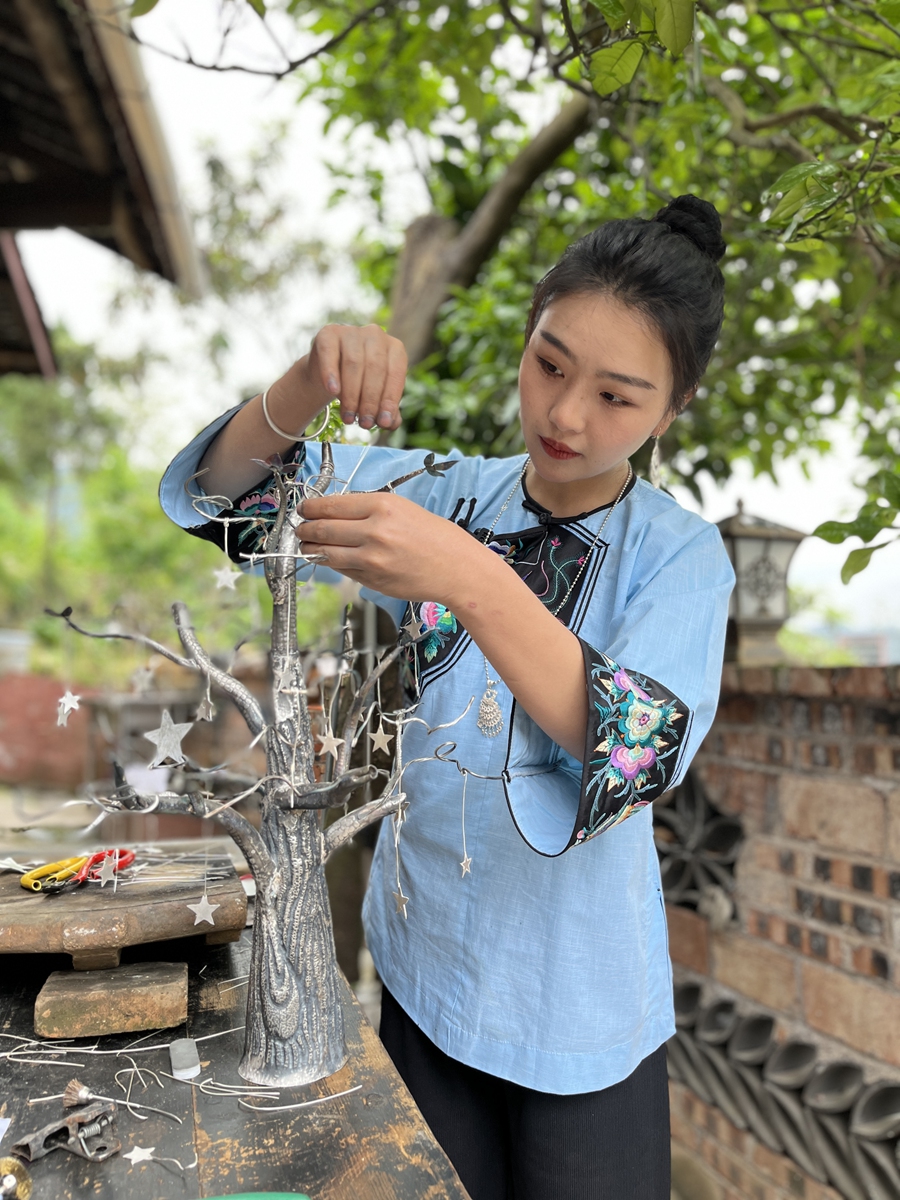ARTS / CULTURE & LEISURE
Gen Z in Guizhou Province goes viral with update to ancient tradition
Reach for the stars

Pan Xue shows her Reach for the Stars art installation. Photo: Courtesy of Pan Xue

Pan Xue shows her Reach for the Stars art installation. Photo: Courtesy of Pan Xue
While most people Pan Xue's age have left Yanzhai village in Southwest China's Guizhou Province to pursue life in big cities, the young Gen Z woman has chosen to return to her hometown to inherit its 1,000-year-old traditional craftsmanship.As people followed the Shenzhou-13 crew's safe return to Earth after their epic six-month orbital mission on Saturday, Pan and her Reach for the Stars art installation went viral on Chinese social media.
"This device was made with intangible cultural heritage techniques to salute the China's taikonauts!" she wrote in the post revealing her work - a small silver tree decorated with stars that was created using the province's silversmithing and laran (a wax-resist dyeing technique similar to Indonesia's batik) techniques.
"When I first heard the news that the three were getting ready to come back to Earth, I began reaching out to the teachers and students from the local batik college. Eventually we completed this tree together using laran cloth and silver decorations," the 25-year-old told the Global Times.
Just like her, many local people have brought this place hidden in the mountains to light through innovative means such as short videos and livestreaming. However, the picture here is completely different from what it looked like five years ago.
'Silver' awakening
In the Qiandongnan Miao and Dong Autonomous Prefecture in Guizhou, the local Miao and Dong ethnic groups gave birth to one of their greatest sources of pride: silver decorations and accessories with detailed and exquisite designs made using techniques that date back more than 1,000 years ago.
However, the art form has been suffering from a lack of successors since young people are hesitant to pursue this line of work for a living as even talented silversmiths have trouble finding channels to sell their exquisite handmade artworks nationwide.
Pan told the Global Times that for generations silversmithing was the life blood of the village, but in today's world they have fallen on tough times.
"Though they have fabulous skill, it is difficult for them to get the world to take notice."
In 1990s, when these ancient villages began to embrace modernity, the traditional craftsmanship suffered from the impact.
"As young people went out into the world, silversmith villages were gutted out."
It was not until 2016 that more people began taking up the mantle of tradition, bringing hope back to the villages. The major factor behind this was the prefecture's nomination of the intangible cultural heritage as a key area for developing tourism and alleviating poverty.
Though extreme poverty has been eradicated in the region, beneficial policies are still in place and have been a boon for Pan and others like her who are new to the field.
"They lower our delivery fees and established a location as a place for us to livestream on [short video platform] Douyin," Pan said.
"Now there are at least 200 households inside our village making and selling silver jewelry."
Building digital bridges
Pan, who has a large number of followers on both Chinese social media and overseas platforms such as YouTube, is not the first young person to turn to the internet to introduce China's intangible cultural heritage to the world.
Wang Wenhua, who worked in China's "Porcelain Capital" Jingdezhen in East China's Jiangxi Province for 14 years, once went viral, earning over 45 million views and 4.2 million likes on Douyin, with a video of a miniature vase only five millimeters tall.
Wang told the Global Times that the short video platform provides a convenient channel for people to learn more about intangible cultural heritage.
"Young people gain an interest in these skills through short videos, and then might combine them with some cool ideas of their own to make creations like Pan's. I think it is a healthy development for intangible cultural heritage skills."
"The prosperous development of traditional handicrafts shows that young people are identifying with their own culture and reflects their confidence in Chinese culture," Zheng Changling, secretary general of the China Folk Culture Innovation and Development Center and a research fellow at the Chinese National Academy of Arts, told the Global Times on Tuesday.
In August 2021, China's State Council issued a document to further strengthen the protection of the intangible cultural heritage, including improving protection systems and stepping up dissemination and popularization efforts.
"Education is the foundation for cultural inheritance and dissemination," Zheng said, suggesting that related classes could be established in elementary and middle schools so that young students could learn about these art forms at an early age.




